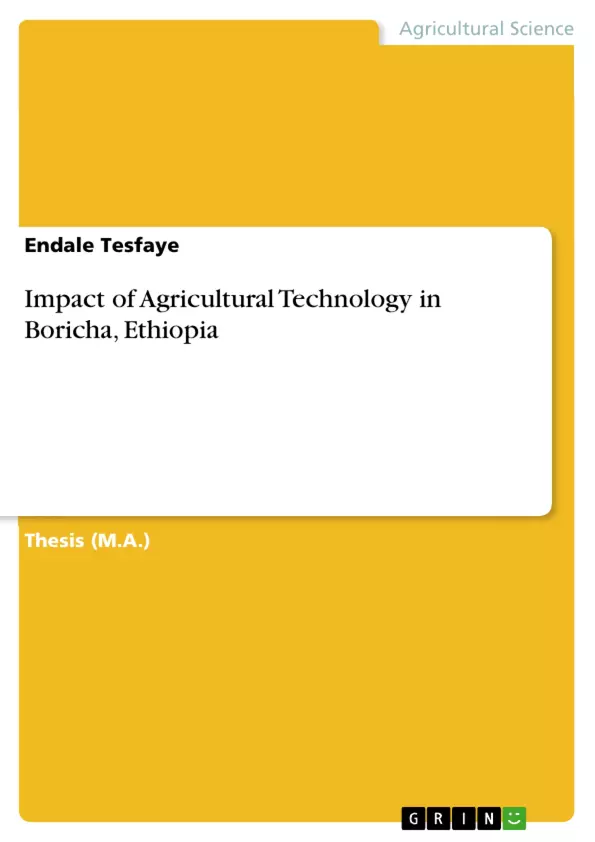The study was carried out in Boricha woreda in Sidama region, Ethiopia, with the objectives of identifying the effect of agricultural technology on livelihood improvement and to analyse the effect of agricultural technology on farmer’s livelihood improvement in Boricha woreda. The study had the following specific objectives: to identify the types of agricultural technology adopted by the farmers, to examine the livelihood status of the farmer improvement, and to analyse the effect of agricultural technology on livelihood improvement. Central research questions are: What are the types of agricultural technologies adopted by farmers? What is the livelihood status of the farmers? What are the sources of livelihood for the farmers?
Boricha was characterized by high incidence of poverty, low rural incomes, low agricultural productivity, and food insecurity. A total of 150 households from agricultural technology adopter farmers were selected randomly. Education levels observed from survey were 36.7% illiterate, 56% join elementary level and 7.3% up to high school level. Family size of the respondents were less than 4 people were 5.3% and 4-6 person were 72.7% and above 6 people were 22%. Land size of the respondents, 26% were in 0.25-0.5 hectare owner and 74% were in more than 0.5 hectare owner.
Inhaltsverzeichnis (Table of Contents)
- CHAPTER ONE: INTRODUCTION
- 1.1. Background of the study.
- 1.2. Statement of the Problem.
- 1.3. Objectives of the study..
- 1.3.1. General Objective.
- 1.3.2. Specific objectives.....
- 1.4. Research Questions
- 1.5. Significance of the study..
- 1.6. Scope of the Study
- 1.7. Limitations of the study
- 1.8. Organization of the Paper.
- CHAPTER TWO: LITERATURE REVIEW..
- 2.1. Theoretical Literature........
- 2.1.1. Agricultural technology adoption
- 2.1.2. Basic concepts and theoretical foundations of adoption analyses
- 2.1.2.1. Risk and adoption of a new technology..
- 2.1.2.2. Speed of technology adoption........
- 2.1.3. Basic Concepts of Technology Adoption
- 2.1.4. Agricultural Development.........
- 2.1.5. Process of Agricultural Technology Adoption in Developing Countries
- 2.1.6. Definition of Technology Adoption
- 2.1.7. Theory of adoption behavior.
- 2.2. Empirical literature
- 2.2.1. Impact of Improved Agricultural New Technologies on Smallholder Farmers............
- 2.2.2. Adoption of Improved Agricultural Technology
- 2.2.3. Factors affecting adoption and intensity of agricultural new technologies in ethiopia.
- 2.2.3.1. Demographic Factors.
- 2.2.3.2. Socio-Economic Factors
- 2.2.3.3. Institutional Factors
- 2.2.3.4. Technological factors.
- 2.2.4. Adoption Status of Agricultural Technologies in Ethiopia.…………………………..\n
- 2.2.5. Agriculture Technologies and General Welfare in Developing Countries
- 2.2.6. Rural Livelihood in Context of Ethiopia
- 2.3. Livelihood strategies of farm household in Ethiopia
- 2.4. Research Gap
- 2.5. Conceptual /analytical frame work
- 2.6. Dependent and independent variables definition, measurement expected gaps.
- CHAPTER THREE: METHODOLOGY.
- 3.1. Description of Study Area..
- 3.2. Agriculture in the study area.........
- 3.3. Livelihoods system in the study area
- 3.4. Research Type.....
- 3.5. Sampling Procedure and Techniques …....
- 3.4. Source of Data
- 3.5. Tools for Data Collection...
- 3.6. Methods of Data Collection
- 3.7. Methods of Data Analysis.....
Zielsetzung und Themenschwerpunkte (Objectives and Key Themes)
The thesis examines the impact of agricultural technology adoption on livelihood improvement in Boricha Woreda, Sidama Regional State, Ethiopia. The study aims to identify factors influencing technology adoption and its effects on farmers' livelihoods.
- Agricultural technology adoption and its impact on livelihoods.
- Factors influencing the adoption of agricultural technologies.
- The role of agricultural technologies in improving rural livelihoods in Ethiopia.
- The relationship between agricultural technology adoption and poverty reduction.
- The effectiveness of agricultural extension services in promoting technology adoption.
Zusammenfassung der Kapitel (Chapter Summaries)
Chapter One provides the background and context of the study, outlining the problem and its significance. It also details the study's objectives, research questions, scope, limitations, and the organization of the thesis.
Chapter Two delves into the theoretical and empirical literature on agricultural technology adoption, rural livelihoods, and their impact on developing countries. It explores the theoretical frameworks and relevant studies, highlighting factors influencing technology adoption and its effects on farm households.
Chapter Three outlines the research methodology employed, including the study area, data sources, sampling techniques, and data analysis methods. This chapter provides a detailed explanation of the research design and approach adopted for this study.
Schlüsselwörter (Keywords)
The study focuses on agricultural technology adoption, livelihood improvement, rural development, Ethiopia, Sidama Regional State, Boricha Woreda, smallholder farmers, factors influencing adoption, impact assessment, extension services, poverty reduction.
- Quote paper
- Endale Tesfaye (Author), 2023, Impact of Agricultural Technology in Boricha, Ethiopia, Munich, GRIN Verlag, https://www.grin.com/document/1403525



